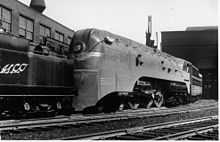MILW class F7
| MILW class F7 | |
|---|---|
| Numbering: | 100-105 |
| Number: | 6th |
| Manufacturer: | ALCO |
| Year of construction (s): | 1937-1938 |
| Retirement: | 1949-1951 |
| Axis formula : | 2'C2 ' |
| Type : | Hudson (Baltic) |
| Gauge : | 1435 mm ( standard gauge ) |
| Length: | 18,440 mm (without tender), 30,480 mm (with tender) |
| Height: | 4,724 mm |
| Fixed wheelbase: | 4,470 mm |
| Total wheelbase: | 12,903 mm |
| Service mass with tender: | 358.8 t |
| Friction mass: | 98.1 t |
| Driving wheel diameter: | 2,134 mm |
| Impeller diameter front: | 914 mm |
| Rear wheel diameter: | 965 and 1,118 mm |
| Number of cylinders: | 2 |
| Boiler overpressure: | 2.07 MPa |
| Grate area: | 8.97 m² |
| Superheater area : | 157.5 m² |
| Evaporation heating surface: | 387.0 m² |
| Water supply: | 63,200 l |
| Fuel supply: | 22.7 tons of coal |
| Control: | Heusinger |

The class F7 of the Chicago, Milwaukee, St. Paul and Pacific Railroad ( Milwaukee Road ) included six streamlined fairing and steam locomotives of the type Hudson 2'C2 '. The machines, designated as the Baltic type in contrast to the New York Central Railroad on Milwaukee Road , were built in 1937 and 1938 to transport the Hiawatha express trains . Building on the success of the Atlantic - Class A , allowed the class F7, still heavier trains on the popular route of the Twin Cities Hiawatha between Chicago and Minneapolis-Saint Paul to pull. Compared to the A-Class, there was a return to coal-firing, for which a new coaling system was specially built in New Lisbon station , which enabled coal to be coaled in two minutes during a scheduled stop.
In recognition of its outstanding streamlined design, which also included the ribbed lightweight wagons with the distinctive “Beavertail” end wagon, the first F7 locomotive No. 100 had a plaque on the cylinder casing that read “Speedlined by Otto Kuhler ” and a facsimile of his signature.
The F7 can claim to be among the fastest steam locomotives ever built in the world. They reached over 160 km / h in everyday operation. During a trip during a heavy snow storm in January 1941, a reporter for the railroad magazine Trains recorded the speed of 177 km / h (110 miles per hour) twice. Baron Gérard Vuillet, a French railroad expert, recorded a top speed of 201 km / h (125 mph) on a trip from Chicago to Milwaukee and an average of 190 km / h over a distance of 7.2 kilometers. Arnold Haas reports on his trip with the Afternoon Hiawatha from Chicago to Milwaukee in July 1946, where an F7 is said to have driven at up to 205 km / h in places.
However, the official world speed record for steam locomotives is still the one that the LNER A4 4468 achieved in 1938 with 202.58 km / h in 1938.
In terms of the scheduled travel speeds that are reached between two train stations, however, the F7s were the world's fastest steam locomotives. In 1939, shortly after the locomotives went into operation, the timetable for the Twin Cities Hiawatha on the 126 km route between Portage and Sparta in Wisconsin was modified so that the route could be covered in 58 minutes at a cruising speed of 130 km / h. This made them slightly faster than the Belgian series 12 , which had previously held the record on the route between Brussels and Bruges .
The first locomotive to go into service with the number 100 was also taken out of service on November 10, 1949. The last locomotive to be built, 105, was taken out of stock on August 10, 1951, as it were, the last of the series. All locomotives were scrapped.
Web links
Individual evidence
- ^ Brian Hollingsworth, Arthur Cook: The Handbook of Locomotives . Bechtermünz Verlag, Augsburg 1996, ISBN 3-86047-138-4 , p. 136 .
- ↑ a b Wolfgang Messerschmidt: The fastest on the rails . Motorbuch Verlag, Stuttgart 1990, ISBN 3-613-01340-1 , p. 86 .
- ↑ a b Jim Scribbins: The Hiawatha Story . University of Minnesota Press (originally published in Milwaukee: Kalmbach Publishing Co., 1970), Minneapolis / London 2007, ISBN 978-0-8166-5003-3 .
- ↑ Ronald Krug: From the train transport service: The fastest steam trains. International comparison of records, top speeds and travel speeds. EK-Verlag, Freiburg im Breisgau 2014, ISBN 978-388255-770-1 , p. 112

